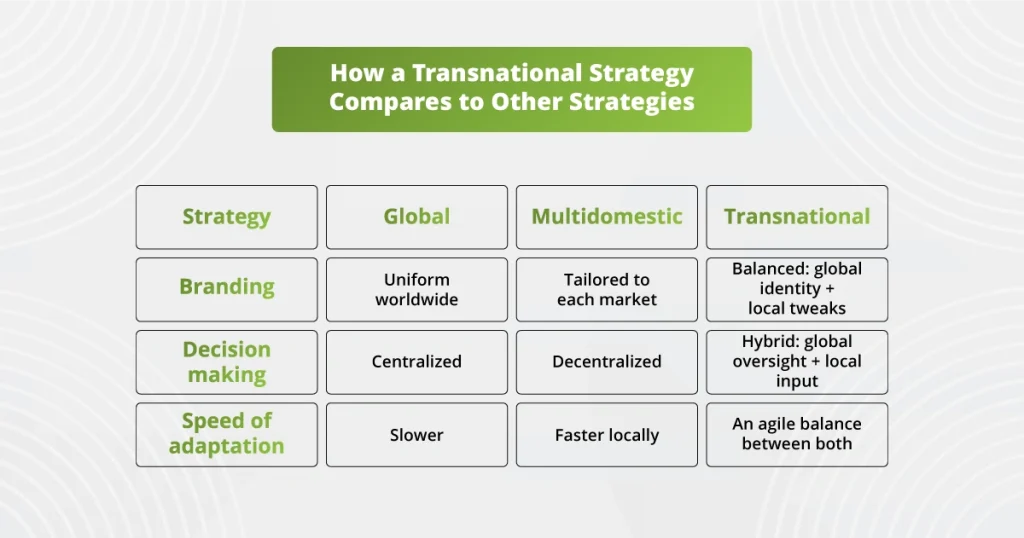You’ve probably noticed that businesses follow different models when expanding internationally. But figuring out which approach is best for your business can feel overwhelming.
In this article, we break down the strategy used by global conglomerates like Google and Unilever: the transnational strategy.
Let’s dive in.
What Is a Transnational Strategy and Why Do Global Companies Use It
A transnational strategy is a hybrid model that combines global integration with local responsiveness. The head office of a company retains overall control of operations from its home country while allowing flexibility to adapt in international markets.
This approach differs from:
- International strategy, where companies expand globally with little to no cultural adaptation
- Multidomestic strategy, where international branches have full autonomy to localize and adapt the brand to local expectations
Think of a transnational strategy as the middle ground, offering the standardization of global strategies and the adaptability of local ones.
Companies expanding globally face a choice: standardize, localize, or do both. A transnational strategy delivers the best of both worlds.
Going International While Maintaining Local Relevance
A transnational strategy is ideal for businesses that want to scale efficiently while ensuring their brand resonates deeply in every local market.
Here’s how it works:
- Centralized Head Office CoordinationGlobal teams set overall direction, ensuring brand consistency and streamlined operations.
- Local Market ResponsivenessRegional teams adapt products, services, and messaging to meet cultural and consumer expectations.

How a Transnational Strategy Compares to Other Strategies
This approach requires agile operations to manage localization and brand consistency simultaneously.
A transnational approach helps you grow efficiently while respecting local cultures, consumer habits, and compliance.
Why More Global Brands Are Going Transnational
- Cost-Effective ScalingShared systems and resources across regions allow businesses to expand without duplicating efforts, keeping operations lean.
- Stronger Competitive AdvantageBy tailoring experiences to local markets, brands can better connect with customers and outpace one-size-fits-all competitors.
- Faster Market PenetrationA flexible localization process enables quicker adaptation to new markets, helping you establish a foothold before rivals.
- Region-Specific AdaptationProducts and services can be fine-tuned for each locale, ensuring your brand resonates with international customers.
- Long-Term Brand ConsistencyEven with local variations, the core brand identity remains intact, supporting trust and recognition worldwide.
Transnational businesses benefit from the flexibility to innovate locally while maintaining global brand equity.
Transnational Strategy in Action: Brand Case Studies
How Dove Challenges Beauty Standards Globally and Locally
Unilever’s Dove campaigns show how a transnational strategy works in practice. Both the English and Arabic versions carry the same core message: celebrating real beauty beyond stereotypes.
But the Arabic campaign is carefully localized to truly resonate with local audiences.
From the use of Arabic calligraphy to nuanced messaging that embraces curly hair—a feature often stigmatized in the Middle East—Dove demonstrates how global brands can remain authentic while adapting to diverse markets.
This balance of global identity and local sensitivity is what makes Unilever a standout among transnational companies.

Google: Global Platform, Local Celebrations
Google’s iconic Doodles are a perfect showcase of its transnational strategy. While the search engine maintains a consistent global interface, its Doodles adapt to reflect the culture and values of each market.
The UAE National Day Doodle and the 4th of July Doodle both celebrate national pride, yet each is uniquely designed with local symbols, colors, and themes that resonate deeply with their audiences.
This approach allows Google to remain a truly global brand while fostering personal connections with users in every local market, proving that even small localized elements can make a big impact.
From language to menu items, these transnational companies know that local wins when managed strategically.

Why Localization Is the Backbone of Transnational Success
A successful transnational strategy depends on how well your brand can integrate globally while responding locally, and localization is the key to making that happen.
Whether it’s website copy, eLearning modules, or marketing transcreation in a transnational strategy, localizing for each target market is non-negotiable in any smart transnational business strategy.
Here’s why it’s non-negotiable:
- Cultural AlignmentLocalization ensures your messaging and tone resonate with local cultures, building trust and relevance across markets.
- Native ExpertiseWorking with regional experts or native teams helps you adapt content and experiences authentically for each target market.
- Regulatory ComplianceFrom product labeling to website content, localization supports adherence to local laws and standards.
- Better User ExperienceLocalized UX leads to higher customer trust and improved campaign performance globally.
What to Watch Out For in Transnational Expansion
Successfully managing both global consistency and local relevance requires careful planning and smart execution.
Here’s what global businesses need to navigate:
- High Coordination DemandsAligning global and regional teams can strain resources without robust processes in place.
- Risk of Brand InconsistencyWithout clear communication and brand guidelines, local adaptations may stray too far from your core identity.
- Increased Strategic ComplexityJuggling multiple expansion strategies while staying responsive to each home country market can slow decision-making.
- Balancing Central Control vs. Local Autonomy Too much control stifles innovation, while too much autonomy risks fragmented operations.
Solutions
- Build cross-border workflows for seamless collaboration.
- Use shared tools to maintain visibility and alignment.
- Partner with trusted localization experts to simplify adaptation and protect brand integrity.
Ready to Scale Globally and Connect Locally? We Can Help
A strong transnational strategy is about building a brand that feels at home anywhere.
At bayantech, we deliver strategy-driven localization that goes beyond translation. With proven results supporting global brands, we help businesses adapt faster, smarter, and with confidence in even the most complex international markets.







